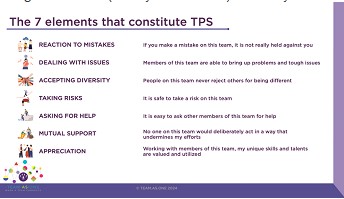Admittedly, that was not exactly how the question was formulated. After talking about the importance of team psychological safety on team learning and team performance, someone asked how all this connects with dealing with a “disgruntled or disruptive” team member. Interesting question, and a few things come to mind.
 The first step is to understand to what extent this disruptive or disgruntled attitude is related to the team. Sometimes the real issue is in fact unrelated to the team, although it may show up in the team setting. There could be issues or dissatisfaction with the company’s policy, salary and benefits, constraints or rules and regulations that are imposed. Or the issue could be outside of the work environment all together: relationship, health, financial or other stress issues rooted in the private sphere of course impact how someone shows up at work. If the issue is clearly outside the team, it makes no sense to look at team psychological safety to come to the rescue. At most, it could smoothen (temporarily) the behavior. However, if the issue is rooted in the way the team works, how decisions are made or how plans are executed, then, yes, this is very much an issue for the team to deal with (more on that further below).
The first step is to understand to what extent this disruptive or disgruntled attitude is related to the team. Sometimes the real issue is in fact unrelated to the team, although it may show up in the team setting. There could be issues or dissatisfaction with the company’s policy, salary and benefits, constraints or rules and regulations that are imposed. Or the issue could be outside of the work environment all together: relationship, health, financial or other stress issues rooted in the private sphere of course impact how someone shows up at work. If the issue is clearly outside the team, it makes no sense to look at team psychological safety to come to the rescue. At most, it could smoothen (temporarily) the behavior. However, if the issue is rooted in the way the team works, how decisions are made or how plans are executed, then, yes, this is very much an issue for the team to deal with (more on that further below).
Labelling someone as disgruntled or disruptive is a strong judgment[1]. I don’t need to interview the concerned team member to guarantee that they will not see themselves as disruptive or disgruntled. They would probably explain that the way things are going is not working, that decisions are not explained, that something that needs to be addressed is not being addressed (or any other issue) and they therefore keep on coming back on this.
 Rather than call a team member disruptive or disgruntled, focus on what exactly it is they do or say? We are often put off by the way something is said. We all have our preferred way of expressing ourselves, and we think that our way is normal, clear and makes sense for everyone else. Of course not everyone expresses themselves as we do. Some think things need to be said as straight-in-your-face as possible – to avoid any misunderstanding – and others prefer to say things in a very indirect way – to avoid ruffling feathers. And there are many variations in between. Try to peel away the way things are said or done and identify what is actually said or done.
Rather than call a team member disruptive or disgruntled, focus on what exactly it is they do or say? We are often put off by the way something is said. We all have our preferred way of expressing ourselves, and we think that our way is normal, clear and makes sense for everyone else. Of course not everyone expresses themselves as we do. Some think things need to be said as straight-in-your-face as possible – to avoid any misunderstanding – and others prefer to say things in a very indirect way – to avoid ruffling feathers. And there are many variations in between. Try to peel away the way things are said or done and identify what is actually said or done.
If the leader or the team judges someone as disgruntled or disruptive, and needing to “be dealt with”, the probability of success in making that member a full part of the team is pretty low.
Once we have made sure the issues or concerns (and therefore the way forward!) mostly lay within the team and we have filtered out the way communication is happening to identify what issues are actually raised, we can take the steps to deal with them inside the team. And that is exactly where team psychological safety comes into play! Several of the 7 elements of team psychological safety[2] can be the direct driver to deal with this situation, like dealing with issues, accepting diversity and taking risks, and some indirectly like appreciation or asking for help. It is in fact a great test of the team’s level of psychological safety to see how it deals with the issues raised by the disgruntled or disruptive team member!
How to make practical progress? I am a big believer in the power of a team to deal with challenges that belong to the team, and it is key that this challenge is seen as a team challenge, rather than “John’s problem”. One way is to ask ALL members of the team to list their concerns about the particular situation (for example in a force-field analysistemplate), so that John’s concerns are captured just like those of the others. The team then works through all the inputs and finds the best way going forward. Not always 100% straightforward but that is the only way to move away from the “bad apple” image and fully embrace the diversity that exists in the team.
For sure not an easy situation in certain cases, but half of the battle is won if we can step away from judging the concerned individual as the “problem case”.
Peter Cauwelier
TEAM.AS.ONE
2023
- Gotian, R. Often Labeled a Misfit, That Troublemaker Might Be An Overlooked Swan. Forbes, 2023.
- Edmondson, A.C., Psychological safety and learning behavior in work teams. Administrative Science Quarterly, 1999. 44(2): p. 350-383.

